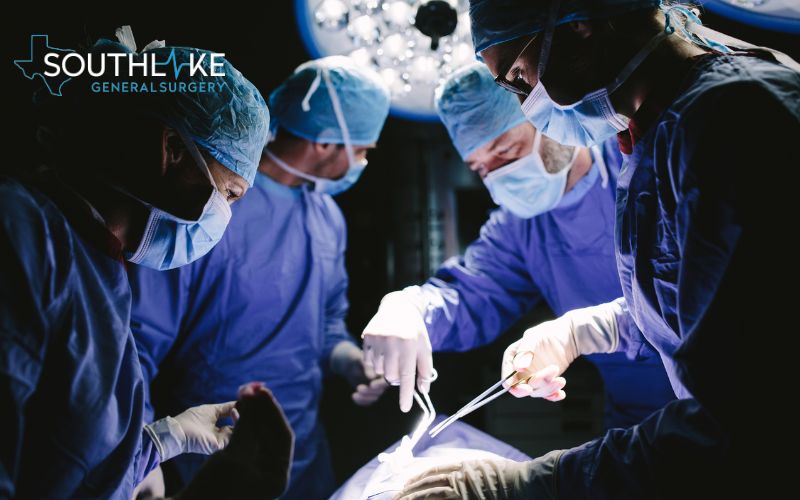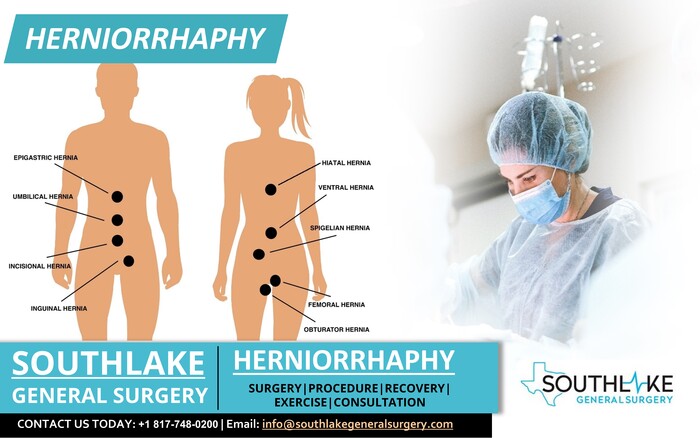A herniorrhaphy is a surgical procedure to repair a hernia. In this procedure, your doctor repairs the weak spot in the abdominal wall. A hernia develops when an organ pushes through an opening of the muscle or tissue of the abdominal wall.
Overview
If a person has a direct hernia, which bulges from the abdominal wall, your surgeon will suggest surgery to push the bulge back to its place and repair the weak spot of the muscle or tissue by stitching the edges with healthy tissue. If the area of weak muscles is large, your surgeon may use a synthetic mesh, also known as surgical mesh, to strengthen and cover the hernia defect in the abdominal cavity.
This procedure is known as hernioplasty and is recommended for individuals who experience discomfort or pain during physical activity or when coughing, sneezing, or standing up.
In some cases, the hernia may appear as a bulge in the groin area and may require surgery, specifically inguinal hernia repair, to fix the issue. It is important to consult with a medical professional to determine the best course of treatment for your specific hernia.
The possibility of a hernia recurrence after surgery is low. The recurrence of a hernia is based on the type of hernia and the surgical procedure. When mesh was not introduced in the medical industry, about 15 percent of the individuals who had hernia repair surgery had a recurrence of the hernia.
However, the use of hernia mesh has significantly reduced the percentage of recurrent hernias, making it a more effective option for treatment with fewer side effects. Postoperative care is also crucial in preventing complications such as wound infection, nerve pain, and recurrence.
Patients should be monitored closely for these potential issues, including monitoring the blood supply to the affected area, to ensure proper healing and recovery.
Herniorrhaphy Procedure

Before surgery, your doctor will prescribe some physical tests to determine if you have a hernia. It is important to inform your doctor if you smoke, are taking any medicines, have any medical history, or are taking blood thinners.
Your doctor can suggest any one of these two procedures to fix a hernia: Open Surgery or Laparoscopic Hernia Surgery (keyhole surgery). Laparoscopic hernia surgery is the most recommended surgical procedure, with less pain and a faster recovery. The possibility of hernia recurrence is similar to these two surgical procedures.
In a herniorrhaphy procedure, your doctor will give a local or general anesthetic based on the type of surgical procedure they choose to fix the hernia.
Once the anesthesia takes effect, your doctor will make an incision parallel to the line of the inguinal ligament to access the hernia sac. Then the surgeon will place the organ back in its original place and suture the abdominal wall.
If the area of the weak spot is large, your surgeon may use the mesh to strengthen the muscles or tissue. At last, the surgeon will close the incision and apply the dressing.
Many people usually get discharged from the hospital the same day after the hernia surgery. However, your doctor will advise you to take complete rest for about two weeks and you’ll be asked to arrange for a friend or a family member to drive you home safely after surgery.
What are the different types of hernias that can be treated with herniorrhaphy?
Herniorrhaphy can treat various types of hernias, including inguinal (inner groin), femoral (outer groin), umbilical (belly button), and incisional (resulting from an incision) hernias. The surgery involves returning the herniated tissue to its proper place and repairing the weakened abdominal wall.
Recovery Time

Recovery after hernia repair surgery (herniorrhaphy) takes about three weeks. Your doctor will give you detailed instructions to follow for a faster recovery. You can walk or carry out light activities and you can have sexual intercourse after your recovery time.
You should completely avoid strenuous activities at least for six weeks after hernia surgery. To reduce the risk of hernia recurrence, you should avoid lifting any weight greater than a gallon of milk for about six weeks.
After your surgery, you may identify some swelling close to the incisional site, which is common. It will reduce with time as you heal. To reduce pain and swelling, follow your doctor’s instructions.
Consult your PCP if:
- you notice bleeding through the dressing
- you have a fever
- the incision site gets red and warm
Cost of Herniorrhaphy
We at Southlake General Surgery, Texas, aim to make the process simple and easier for our patients and we work with multiple insurance providers on behalf of our patients. We help our patients or clients find out more information about their insurance plans and benefits and work with them to find affordable payment plans for their account balances.
Risk and Complications
Risk is always associated with any surgical procedure that requires anesthesia. Risks and complications may include:
- damage to veins
- bleeding or infection from the surgical wound
- injury to internal abdominal organs
- injury to the vas deferens in men
- after surgery anesthetic reaction
- Infection of mesh
- numbness
Conclusion
In conclusion, surgeons use herniorrhaphy as a surgical procedure to repair a hernia, which happens when an organ or fatty tissue bulges through a weak spot in the surrounding muscle or connective tissue. The surgery involves pushing the herniated tissue back into place and repairing the weakened area of the muscle or tissue.
There are different techniques used for herniorrhaphy, including open repair and laparoscopic surgery. However, it is important to note that certain risk factors, such as age, obesity, pregnancy, family history, occupation, and constipation, can complicate hernia repair surgeries and increase the risk of negative side effects or the surgery failing.
Recovery time can vary depending on the individual and the type of procedure performed, but most patients can expect to return to normal activities within a few weeks. It is important to follow post-operative care instructions provided by the surgeon to ensure a successful recovery and minimize postoperative pain.
Overall, herniorrhaphy is a safe and effective treatment option for hernias, with high success rates and low risks of complications. With the use of advanced technology and techniques, such as laparoscopic surgery, surgeons can repair hernias in various locations, including the femoral canal, with minimal invasiveness and faster recovery times.
Surgeons can successfully repair femoral hernias through herniorrhaphy, which provides relief from severe, long-term groin pain and improves the quality of life for patients.
Appointment
For more information on Herniorrhaphy and Laparoscopic hernia surgery. You can contact our healthcare expert today at +1(817) 748-0200. You can also make an online appointment with us.
Medically Reviewed By: Dr. Valeria Simone MD
Board-certified General Surgeon at Southlake General Surgery, Texas, USA.
Follow us on Facebook and YouTube.
References:
- Gopal, S. V., & Warrier, A. T. (2013, June 1). Recurrence after groin hernia repair-revisited. International Journal of Surgery. https://doi.org/10.1016/j.ijsu.2013.03.012
- Viscusi E, Minkowitz H, Winkle P, Ramamoorthy S, Hu J, Singla N. HTX-011 reduced pain intensity and opioid consumption versus bupivacaine HCl in herniorrhaphy: results from the phase 3 EPOCH 2 study [published correction appears in Hernia. 2020 Jun;24(3):679]. Hernia. 2019;23(6):1071-1080. doi:10.1007/s10029-019-02023-6
- Mann CD, Luther A, Hart C, Finch JG. Laparoscopic incisional and ventral hernia repair in a district general hospital. Ann R Coll Surg Engl. 2015;97(1):22-26. doi:10.1308/003588414X14055925058913
- HerniaSurge Group. International guidelines for groin hernia management. Hernia. 2018;22(1):1-165. doi:10.1007/s10029-017-1668-x

